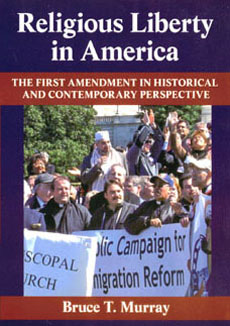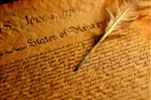
In recent years a series of highly publicized controversies has focused attention on what are arguably the most important 16 words in the U.S. Constitution:
“Congress shall make no law respecting an establishment of religion, or prohibiting the free exercise thereof ...”
The ongoing court battles over the inclusion of the words “under God” in the Pledge of Allegiance; the seasonal cultural quarrel over “Merry Christmas” vs. “Happy Holidays”; and President George W. Bush’s Faith-Based and Community Initiative – all of these issues reflect competing views of the meaning of the Religious Liberty Clauses of the First Amendment.
Such disputes, as Bruce T. Murray shows, are nothing new. For more than 200 years, Americans have disagreed about the proper role of religion in public life and where to draw the line between church and state. In this volume, Murray re-examines these debates and distills the volumes of commentary and case law they have generated. He analyzes not only the changing contours of religious freedom but also the phenomenon of American civil religion, an outlook grounded in the notion that the American experiment is sanctified by a higher authority. This idea can be traced back to the earliest New England colonists and remains deeply ingrained in the American psyche.
Throughout the book, Murray connects the past and present, tracing the historical roots of contemporary controversies. He considers why it is that a country founded on the separation of church and state remains singularly religious among nations, and he concludes by showing how the Supreme Court’s thinking about the religious liberty clauses has evolved since the late eighteenth century.
“Bruce Murray seeks to lay out historically and conceptually the issues behind the two religious liberty clauses in the First Amendment. In doing so, he introduces and traces such significant topics as the development of religious pluralism and its ironic counterpart, civil religion. Nowhere is there such a clear and concise explanation of the issues as Murray offers in this book.”
– Philip Goff, Professor of Religious Studies and Director of the Center for the Study of Religion and American Culture, Indiana University-Purdue University, Indianapolis.
Religious Liberty in America was selected by Choice – a publication of the Association of College and Research Libraries – as an “Outstanding Academic Book."
“This book is a splendid presentation of the First Amendment, 'with civil religion as a parallel theme' — especially as presently related to so many issues in American political and religious life. Other books on these issues have been appearing of late, but none as clear and thorough as this one.
Bruce T. Murray, a journalist, hopes this book is 'an easy read on a tough topic.' His hope is definitely realized in this volume, which should be required reading for all journalists who touch on this book's subject.”
— G.H. Shriver, Professor Emeritus, Georgia Southern University (from the October, 2008 issue of Choice, a publication of the Association of College and Research Libraries, a division of the American Library Association.)
Other reviews:
“This concise and readable book discusses topics relating to the religion clauses of the First Amendment and, more generally, to the interaction of religion and politics in the United States. ... It is a highly accessible introduction to the topics it addresses, complete with references for documentation or further reading. ... The book is well written, engaging, and balanced in its presentations of competing views.”
— Daniel O. Conkle, Professor of Law and Adjunct Professor of Religious Studies, Indiana University (from the July, 2009 issue of the Catholic Historical Review).
“Religious Liberty in America engages a complex set of issues, especially welcome when matters of faith and politics have become so prevalent in public discourse. ... Murray covers a lot of ground in this relatively short book. In general, he nicely summarizes divergent views on religion's role in public life, capturing key moments in the development of religion in the formation of the nation, the U.S. Constitution, revivalism, and the origins of civil religion, exploring linkages between religion and the concepts of nationhood and belonging. The book provides short and readable summaries of this terrain for readers seeking succinct discussion of the issues.”
— David A. Reichard, California State University Monterey Bay, The History Teacher, February 2009
Religious Liberty in America is available at numerous university libraries, and it may be purchased from the University of Massachusetts Press.
Find out more about the author on SageLaw.
|




